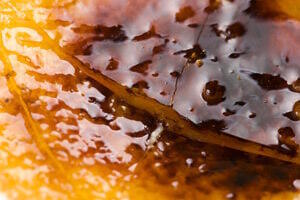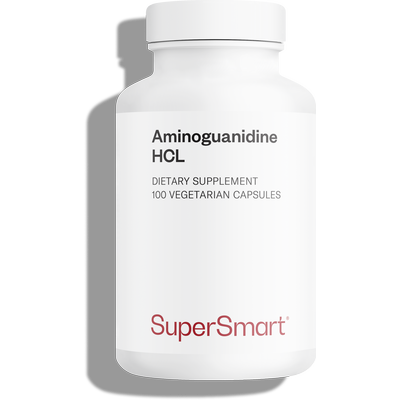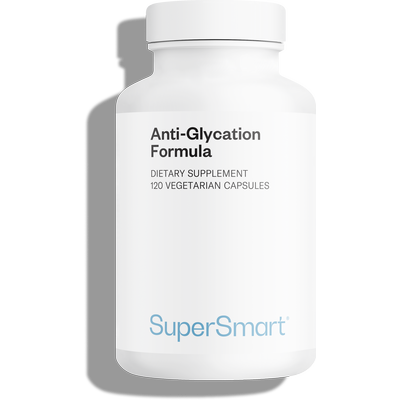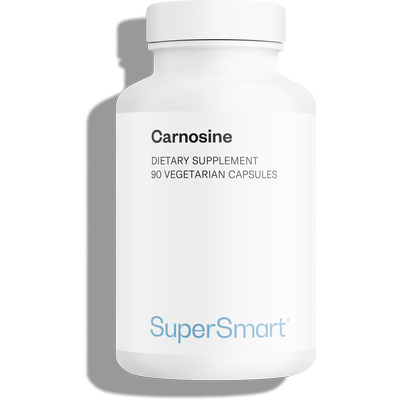05-12-2016
Glycation, a little-known mechanism of ageing
 Glycation is the third - and least-known - of the fundamental mechanisms of ageing, after oxidation and hormonal decline. Our bodies are under threat not only from ‘rusting’, ‘rancidity’, and atrophy of our glands, but also from insidious caramelisation of our proteins, resulting from chronically high blood sugar levels. Glycation, sometimes called non-enzymatic glycosylation, has quietly entered the medical world as a result of glycated haemoglobin (HbA1c) tests which are routinely used as a marker of hyperglycaemia during the monitoring and control of diabetes. Research conducted over the last 20 years shows that glycated proteins, or Advanced Glycosylation End-products (AGEs), play a key role in cell and tissue damage in diabetes, vascular ageing and kidney failure. Nutritional supplements, primarily carnosine-based, can help prevent this process.
Glycation is the third - and least-known - of the fundamental mechanisms of ageing, after oxidation and hormonal decline. Our bodies are under threat not only from ‘rusting’, ‘rancidity’, and atrophy of our glands, but also from insidious caramelisation of our proteins, resulting from chronically high blood sugar levels. Glycation, sometimes called non-enzymatic glycosylation, has quietly entered the medical world as a result of glycated haemoglobin (HbA1c) tests which are routinely used as a marker of hyperglycaemia during the monitoring and control of diabetes. Research conducted over the last 20 years shows that glycated proteins, or Advanced Glycosylation End-products (AGEs), play a key role in cell and tissue damage in diabetes, vascular ageing and kidney failure. Nutritional supplements, primarily carnosine-based, can help prevent this process.
Biochemistry of glycation
Glycation is a distinct chemical reaction resulting from the attachment of a reducing sugar molecule (glucose or fructose) or an aldehyde to amino acid residues in proteins, primarily lysine and the N-terminal amino acid function (NH2 radical). This reaction, which is highly dependent on the period of exposure to sugar and on blood glucose concentrations, occurs without enzymatic participation and forms a product called the Schiff base.This initial stage is often followed by a molecular reorganisation called the Amadori rearrangement. This is either a change in spatial conformation (isomerisation) of the Schiff base, or the attachment to the protein amino function of a sugar oxidised by radical reaction. This rearrangement can be reversed by chemical hydrolysis. This rearrangement structure is called an Amadori product and the rate at which Amadori products are formed is in proportion to the concentration in sugar.
A more complex response called the Maillard reaction then occurs which results in the formation of AGEs, better known as Maillard products after the French scientist who discovered them. The rate at which they form is independent of the medium’s concentration in sugar but depends on the duration of hyperglycaemia (excess sugar) and the rate of protein turn-over.
While the first two stages stabilise at a certain level and can be reversed depending on the degree of glycaemia, this third stage is irreversible and progresses irrespective of glucose blood levels. It generates reactive compounds responsible for the ageing of tissues. Hence Lyons demonstrated the benefits of four months’ improved blood sugar control on early glycation products in skin collagen, but the absence of reversibility of AGEs. Moreover, the products formed in this way can no longer be destroyed or released from the cell. Our cells do have small organelles called proteasomes which degrade unneeded proteins by breaking them into peptides of 9-12 harmless amino acids. But proteasomes cannot degrade glycated proteins which bunch together in the cell and become impossible to get rid of. Gradually, these substances disrupt the metabolism of the cell and ultimately lead to its death. They are aromatic compounds, coloured with brown pigmentation and are fluorescent and antigenic.
Glycation, a phenomenon of cooking
The reaction rate increases with rises in temperature and formation of Amadori products. When food is heated at high temperatures (> 100°C and especially > 180°C) in the oven or on the hob, the reaction is called Strecker degradation. This is autocatalytic destruction of glycated proteins, culminating in the formation of the Maillard products which give food its browned appearance and aroma. The browned or charred parts of food bring health risks and should be avoided; their harmful effects persist in the body just like those of smoking. In terms of toxicity, eating a well-grilled steak is almost equivalent to smoking 1000 cigarettes. It is therefore no surprise that incidence of digestive cancers correlates with consumption of grilled meat. Grilled vegetables are less toxic but should still be avoided where possible.Consequences of glycation
The glycation of proteins has multiple effects. Once glycated, proteins lose some of their properties, with significant outcomes for cell metabolism and function. Glycation of circulating plasma proteins may occur, affecting mainly albumin, insulin and immunoglobulin.Glycation alters enzyme activity either by the presence of a glycated lysine residue close to the active site of the enzyme, or by conformational modification related to cross-linking. Most affected are the antioxidant enzyme copper-zinc superoxide dismutase (SOD) in plasma and the alcohol-detoxifying liver enzyme, alcohol dehydrogenase. Glycation alters the binding of regulating molecules, such as 2,3 diphosphoglycerate (DPG) to haemoglobin and heparin to antithrombin III (the coagulation cascade). Supplementing with vitamin B6 appears to rectify problems of haemoglobin affinity for oxygen by countering glycation of haemoglobin. Glycated haemoglobin (HbA1c) accounts for 4.2% of total haemoglobin in healthy people and 7.5% in diabetics.
Glycation forms aggregates between proteins: a principal mechanism is the exposure and oxidation of SH sulfydryl groups which form into disulphide bridges. Another is the formation of covalent bonds between AGEs which plays a part in excessive vascular permeability and lens opacification. A third mechanism is the covalent capture of plasma proteins in reactive groups generated by glycation, promoting deposits of albumin, immunoglobulin (Ig)G and LDL lipoproteins in arterial walls.
Glycation of proteins in vascular walls causes them to lose some of their mechanical properties and makes them resistant to the enzymes necessary for remodelling of the walls. It thus contributes to the irreversibility of the thickening of the artery wall. It reduces both membrane fluidity and susceptibility to proteolysis. Structural changes are responsible for the leakage of albumin into urine (microalbuminuria). Changes in cell binding domains and disruption to assembly between molecules, by reducing endothelial cell adhesion, promote abnormal cell proliferation. Alterations in fibrinogen and fibrin encourage vascular fibrin deposits and smooth muscle fibre proliferation. Disruption to the properties of elastin reduces elasticity in large blood vessels, increases filtration through the carotid artery and causes defective vasodilation.
Glycation disrupts the function of nucleic acids (DNA), a process implicated in chromosomal breakage, characterised by defective repair, replication and transcription processes, in cell senescence and in the genesis of congenital malformations in diabetic pregnancies.
Glycation modifies immunogenicity which, though reduced for Amadori products, seems to be increased for glycation end products. The presence of autoantibodies, primarily IgA, acting against the latter have been demonstrated in diabetics. In addition, a decrease in the antibody potency of glycated immunoglobulin G (IgG) has been observed.
Glycation is responsible for defects in the recognition of molecular signals and endocytosis (internalisation by cells of foreign bodies). Glycation of low density lipoproteins (LDLs) lowers their uptake by normal receptors. Reduced binding of glycated high density lipoproteins (HDLs) and glycated AI lipoparticles (LpAI) has also been observed: this leads to a decrease in cholesterol efflux; in other words, cholesterol return is less efficient. Glycation of LDL and HDL3 in macrophages is responsible for increased synthesis of cholesterol esters. Together, this promotes hypercholesterolaemia. Glycated lipoproteins are rapidly captured by receptors and are cellular activators.
General effects of glycation products
In macrophages, endothelial cells, smooth muscle fibres and fibroblasts, there is a specific AGE receptor called RAGE (Receptor of Advanced Glycation Endproducts) which is distinct from scavenger receptors (trapping oxidised LDLs). Its expression is inhibited by insulin and increased by Tumour Necrosis Factor (TNF). The binding of AGEs to the RAGE in cells leads to so-called ‘activated’ cell states: it triggers the production of free radicals, powerful oxidants responsible for many damaging effects; it stimulates expression of adhesion molecules and unleashes a pro-coagulant effect; it promotes the secretion of extracellular messengers, primarily cytokines (TNF-alpha, interleukin 1, interferon) and growth factors (PDGF, IGF-1, VEGF); moreover, the increased secretion of vascular growth factor, VEGF (Vascular Endothelium Growth Factor) is thought to be responsible for diabetic retinopathy. All these messengers may be the starting point for an inflammatory response as well as vascular and neuronal deterioration.Products that prevent AGE formation
It seems clear then that the pathogenicity of protein glycation is due to AGEs. Pharmacological and nutritional interventions must therefore intercede prior to their formation and block reactive sites at the level of Amadori products.
Aminoguanidine
Aminoguanidine is a guanidine-derived pharmaceutical substance which has been marketed for the past ten years. It binds to early glycation products by forming a non-reactive, non-cross linking compound. In the retina, aminoguanidine prevents the formation of both AGEs in micro-vessels, and micro-aneurysms, and inhibits the development of diabetic retinopathy. In the kidneys, it prevents AGE formation in renal glomeruli and reduces excretion of albumin in diabetics by 90%. In neurons, it prevents the onset of diabetic neuropathy by stopping the reduction in nerve conduction velocity, normalising the magnitude of potential action of the nerve impulse and stabilising blood flow to peripheral nerves. Finally, aminoguanidine improves the elasticity of the arteries.
Carnosine
Carnosine (or L-carnosine) first appeared more than a century ago. Its anti-ageing properties have recently been demonstrated. Naturally present in skeletal muscle and in the brain, carnosine (beta-alanyl-L-histidine) is a dipeptide molecule (a combination of two amino acids, beta-alanine and histidine). It is formed by the action of carnosine synthetase which creates a bridge between these two amino acids. Its concentration in tissues is determined by the balance between its synthesis by carnosine synthetase and its inactivation by carnisanase. High levels of carnosine are found in cells with a long lifespan (such as neurons). Carnosine concentration in muscles is positively correlated with longevity, making it a potential biomarker of ageing. Concentration is high in actively contracting muscles and low in certain muscle diseases such as Duchenne muscular dystrophy. Muscle concentrations decline with age and carnosine supplementation is thus strongly recommended for older individuals.
Its most significant effect is in countering glycation. Carnosine reacts with sugars such as glucose, galactose and dihydroxyacetone to form glycated carnosine. Of these three sugars, the most reactive is dihydroxyacetone. Carnosine reacts with dihydroxyacetone more rapidly than with lysine, which suggests this dipeptide competes with other sources of amino acids for glycation. In addition, carnosine inactivates proteins glycated by dihydroxyacetone. Carnosine therefore reduces protein glycation and AGE formation. This has been shown with high levels of carnosine, of the same order of magnitude as the concentration of sugar or amino acids in the medium. Carnosine improves the recognition of AGEs by their macrophage receptor. The concentration of carnosine required to inhibit glycation should reflect the level of sugar. In the presence of carnosine, the formation of lipofuscin (age-related fluorescent pigments consisting mostly of oxidised fats) occurs not at the expense of a protein but by sacrificing the carnosine. Like vitamin E, carnosine is an antioxidant that protects and stabilises cell membranes, and supplementing with carnosine actually increases levels of vitamin E. Carnosine may offer both preventive and therapeutic efficacy. Malondialdehyde (MDA), a highly-reactive end-product of lipid peroxidation, is blocked by carnosine which in inactivating MDA, is sacrificed to protect amino acids in muscle proteins. The lipofuscin formed in this way is generally inactive. Carnosine supplementation has been found to inactivate high levels of free radicals and toxins. The glycation products obtained with lysine and arginine are mutagenic (cancer-promoting), while those obtained with histidine and carnosine are not. Glycated carnosine is non-toxic; the body is able to eliminate it.
Reduced concentrations of carnosine were found in the lenses of animals with cataracts, the decrease correlating with the severity of the cataract. In rabbits fed a high-cholesterol diet, carnosine supplements protected against the formation of atheromatous plaque and cataracts. Carnosine supplementation also reduced cataract formation in diabetic rats and dogs. Its activity has been shown to be comparable to that of aminoguanidine, discussed above.
Carnosine also plays a role in neurotransmission. It is a metal ion chelator, modulating enzyme activity. It has antineoplastic properties, making it potentially beneficial in cancer prevention. It stimulates the maturation of immunocompetent cells and reduces inflammation. It promotes wound-healing and protects against radiation damage. In an in vitro study, carnosine extended the lifespan of skin fibroblasts and revitalised advanced senescence cells which have less proliferative capacity with age. Its potential applications are in the treatment of burns and post-surgical wounds, particularly in older individuals. It reduces gastric ulcers (particularly those linked to stress) both by preventing the formation of ulcers and helping them heal. Carnosine treatment prevents or reduces cell damage caused by amyloid beta protein, by blocking and inactivating AGEs and the amyloid beta protein itself, thus making it protective against Alzheimer’s disease.
In a preliminary study, in which 20 healthy volunteers took daily carnosine supplements for between one and four months, no side-effects were observed; on the contrary, half the subjects noticed improvements in their facial appearance, muscle strength or general well-being, and for some, in their sleep and libido. While these benefits were felt after a short time, long-term supplementation is required to produce the anticipated anti-ageing effects.
Conclusion
Glycation is a ubiquitous process that plays a part in ageing. Maillard or glycation products also contribute to the development of several diseases such as cataracts. They are responsible for the complications of diabetes, primarily microangiopathy and nephropathy.Apart from long-term, close control of our blood sugar and minimal consumption of char-grilled foods, the only means currently available to help us combat the harmful effects of AGEs are supplementing with aminoguanidine, a well-documented chemical glycation-inhibitor, and carnosine, a non-toxic, natural molecule which has been around for over 100 years. Carnosine is equally as effective as aminoguanidine. It intervenes at the early stages of glycation to form harmless products that are rapidly eliminated. Carnosine represents a new weapon in the fight against ageing and more specifically, a treatment for degenerative diseases, especially diabetes in which degenerative processes are accelerated. In addition, it appears to offer benefits in treating ulcers and healing wounds.
Références
WAUTIER Jean-Luc. Les produits de glycations avancée ou produits de Maillard. La Revue du Praticien 1998, 48
BENHAMOU Pierre-Yves. Biochimie des Complications Vasculaires du Diabète. Synthèse du 14ème Congrès de l'IDF, Washington DC, juin 1991. http://www-sante.ujf-grenoble.fr/SANTE/Serveur-diabèto/Complications/microangiopathie-2.html
BROWNLEE Michael. Advanced Protein Glycosylation in diabetes and Aging. Ann Rev Med. 1995, 46 : 223-234
TRIGG Tim. Carnosine - Novel strategies to prevent the formation of Advanced Glycation End Productis using Carnosine and Carnosine Stabilizers. http://www.peptech.com/ncs-carn.htm
Order the nutrients mentioned in this article

In the hydrochloride (HCL) form used in clinical anti-glycation studies
www.supersmart.com
A cutting-edge formulation that inhibits the effects of glycation on ageing
www.supersmart.comFurther reading
10-10-2016
In India, turmeric is used to treat a wide variety of ailments including gastrointestinal problems, inflammation, headaches, infections and colds. It is turmeric’s curcuminoid content,...
Read more06-07-2019
If you haven’t yet come across the medicinal plant gymnema (Gymnema sylvestris) , you may be surprised by just how many health benefits it offers....
Read more23-04-2019
How much do you know about non-alcoholic hepatic steatosis? Are you aware, for example, that it is considered one of the most common liver diseases...
Read more© 1997-2025 Fondation pour le Libre Choix
All rights reserved
All rights reserved
Free
Thank you for visiting our site. Before you go
REGISTER WITHClub SuperSmart
And take advantage
of exclusive benefits:
of exclusive benefits:
- Free: our weekly science-based newsletter "Nutranews"
- Special offers for club members only


















